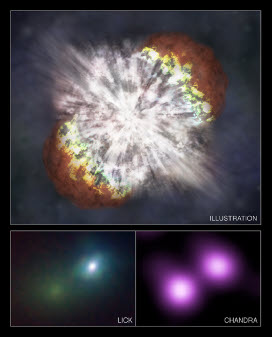

science
Please mouseover difficult words to see what they mean
News
University of California - Santa Cruz: Embargoed for release: 14-Nov-2007 13:00 Eastern US Time
How to make the brightest supernova ever
A supernova observed last year was so bright that it challenged our understanding of what causes supernovae. SN 2006gy was a whole lot more spectacular than its name. At 100 times as luminous as a typical supernova it was the brightest ever recorded.
Stan Woosley had an idea that he thought could explain what happened. He is professor of astronomy and astrophysics at the University of California, Santa Cruz.
His idea is that an extremely massive star can explode not once, like a normal supernova, but again and again. When Woosley and two colleagues did detailed calculations for their model, the results matched the observations on SN 2006gy.
The researchers describe their model in a paper to be published in the November 15 issue of the journal Nature. Woosley's co-authors are Sergei Blinnikov and Alexander Heger of Los Alamos National Laboratory. Blinnikov is a visiting researcher at UCSC from the Institute of Theoretical and Experimental Physics in Moscow.
SN 2006gy was a "stupendously bright supernova", says Woosley - "and we think we have the leading model to explain it."
Astronomers usually think of a supernova as the death of a star, he added, "but in this case the same star can blow up half a dozen times."
The first explosion throws off the star's outer shell. This produces a not-very-bright display. The second explosion puts another supernova's worth of energy into a second shell. This expands at very high speed until it collides with the first shell. When this happens it produces an extraordinarily brilliant display.
In this model far more of the kinetic energy of the explosion is converted into light than in a normal supernova - which converts only 1% of its kinetic energy into light.
"The two shells collide out at a distance such that the full kinetic energy is converted into light," Woosley said. "So it is up to 100 times more luminous than an ordinary supernova."
This new mechanism needs an extremely massive star. It would have to be 90 to 130 times the mass of the Sun. As a star this huge nears the end of its life, the temperature in the core gets extremely hot.
Some gamma rays convert into pairs of electrons and positrons. The result is something called pair instability. Radiation pushes outward, but electrons and positrons don't to the same extent. So some of the radiation pressure that is holding the star up against the inward pull of gravity vanishes. The star collapses in on itself.
"As the core contracts it goes deeper into instability until it collapses and begins to burn fuel explosively," Woosley said. "The star then expands violently."
For stars between 90 and 130 times the mass of our sun, this cycle can happen several times. "It hits this instability, violently expands, then radiates and contracts until it gets hotter and hits the instability again. It keeps going until it loses enough mass to be stable again."
Stars large enough for this to happen are very rare in our own galaxy. But they may have been more common in the early universe. "Until recently, we would have said such stars don't exist," Woosley says.
"But any mechanism that could explain this event requires a very large mass."
Other researchers had suggested pair instability as a possible mechanism for some supernovae. But the idea of repeated explosions is new. The scientists are calling it pulsational pair instability.
According to Woosley, the new mechanism can produce a variety of explosions.
"You could have anywhere from two to six explosions, and they could be weak or strong," he said. "A lot of variety is possible."
It gets even more complicated, he added. What is left behind at the end of all the collapsing and expanding is still a huge star - about 40 times the mass of our sun. "This continues to evolve and eventually makes an iron core and collapses, so you can end up with a gamma-ray burst.
"The possibilities are very exciting."
More help with words
antiparticle
electromagnetic
energy
properties
radiation
What's it all about?
More learning and teaching resources
Teachers' Domain has a lovely online video explaining what happens in a normal supernova and how the elements form. One of the narrators is the lead researcher in this latest story, Stan Woosley.
Working in groups students can watch the video then try to answer the following questions:
